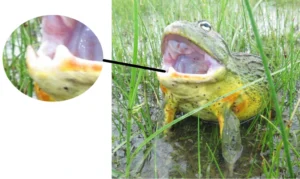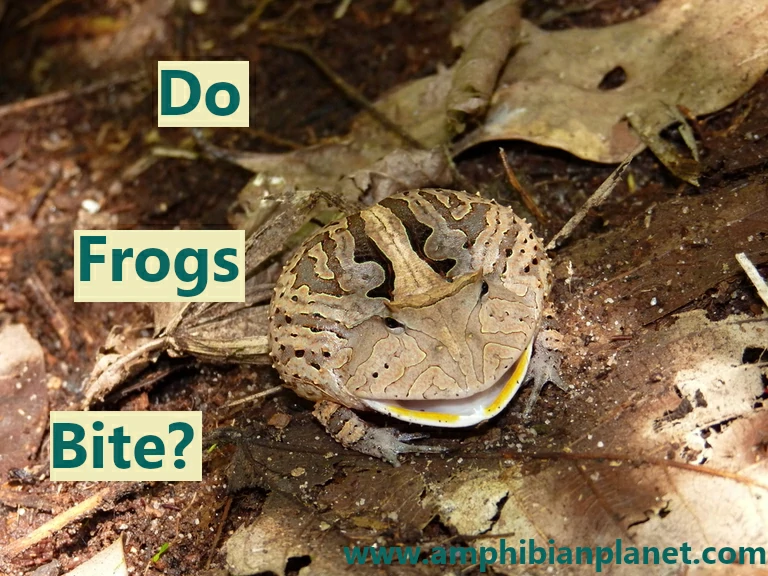Frogs are intriguing creatures that attract the curiosity of many people. Many species also tend to be very secretive, so they are not frequently encountered most times of the year. Because of this, there are many misconceptions about these animals.
Frogs can bite. However, most frogs are very docile and will rarely intentionally bite a human. The most likely time a frog will bite is during aggressive feeding when it mistakes your hand or finger for food, when it feels threatened, or is being handled in a way that makes it uncomfortable.
A bite from the vast majority of frogs will usually be completely harmless. The frog’s tiny teeth are unlikely to penetrate your skin, or draw blood. Its teeth may feel like sandpaper brushing against your skin, but usually nothing more.
That being said, it’s important to note that some large frog species such as African bullfrogs (Pyxicephalus adspersus), and Pacman frogs (Ceratophrys) have relatively powerful jaws, and are capable of delivering a painful bite that can draw blood.
Why Do Frogs Bite?
The majority of frog species are instinctively attracted to movement while hunting for food.
For example, putting a dead fly in front of a frog will elicit no response, but, if the fly is moving – the frog will quickly notice and launch its long sticky tongue to catch the fly.
Frogs have cells called “feature detecting cells” in the visual part of their brain (Optic tectum) that are sensitive to key features of their prey; size, shape, contrast, and movement.
However, they are not exactly the smartest creatures, so a frog can easily mistake a moving finger for food and react by biting the finger.
Many frog species may also bite as an act of self-defense to protect themselves from predators (which includes humans).
There are usually clear signs (body language) leading up to a defensive bite. Some frogs will try to frighten you by making themselves appear big and may also create loud noises.
Also, frogs such as the African bullfrog (Pyxicephalus adspersus) are generally more aggressive and are more likely to bite than other frogs.
A Bite From Most Frog Species Is Completely Harmless
Although frogs do bite, a bite from the vast majority of frog species will usually be completely harmless.
Most frog species have tiny teeth around the edge of the jaw, known as Maxillary Teeth – and also have teeth on the roof of their mouth known as Vomerine Teeth.

These teeth are usually less than a millimeter long, so chances are, you would not notice them even if you opened a frog’s mouth.
While we have teeth dedicated to specific functions (such as canines to rip apart food, incisors to bite, and molars to grind), frogs do not. Their teeth are fairly uniformly conical and do not specialize.
True toads do not have any teeth at all. A bite from a toad will usually be completely harmless.
Some Frogs Can Deliver a Painful Bite
In general, the bigger the frog, the stronger its jaws and it harder it bites. For example, a large bullfrog will have a much stronger bite than a small poison dart frog.
Large frog species such as bullfrogs use their relatively powerful jaws to maintain a firm grip on mice, birds, snakes, frogs, and other large prey items, as they swallow them whole.
Pacman frogs have a bite force of about 30 newtons, which is equal to 3.06 KG or 6.74 lbs. This means they can bite with a force several times their body weight.
African bullfrogs (Pyxicephalus adspersus) are also notable for the fang-like bony projections on their lower jaw. They have one small “fang” in the very center of the lower jaw, and two larger ones on either side.

These projections are not considered true teeth and are likely used in combat for access to prime mating sites and to protect themselves from predators.
They can also be used to inflict a painful bite that can draw blood.
Can a Frog Bite Your Finger Off?
No known frog can bite off a human finger. A bite from large frog species such as the African bullfrog may be fairly painful and cause a small wound, but will typically not do any serious harm. In the vast majority of frog species, the tiny teeth will not even penetrate your skin.
It is unlikely that you will ever have to rush to the local emergency room after a bite from a frog.
What to Do if You Get Bitten by a Frog
In the event that you get bitten by a frog, you should take a few precautions to protect both you and the animal.
Frogs will typically let go shortly after biting. However, there are cases in which a frog will bite and clamp on for an extended period. Should this happen,
- Use your other fingers to slowly push it off your finger.
Be gentle and do it close to the ground, so you don’t hurt the frog in the process.
Once the frog releases;
- Carefully inspect the bite area for any blood or breaks in the skin.
- Very thoroughly wash the bite area with anti-bacterial soap, under running water, to prevent any infection.
Just this will be sufficient for most frog bites. However, in the rare situation that the bite causes serious damage, it is advisable to seek medical attention.
Can You Get Poisoned by a Bite From a Frog?
Many frog species are poisonous to varying degrees. When stressed, they produce noxious skin secretions that make them distasteful or even lethal to most predators.
However, although many frog species are poisonous, their bites are not venomous. Confused? Well, this is most likely due to a misunderstanding of the terms “venomous” and “poisonous”.
To make things simple:
- If an animal has to bite or sting you to inject its toxins, it is venomous.
- If an animal secretes its toxins outside of its body, and you absorb the toxins when you come in contact with the animal, it is poisonous.
In other words, Venom is actively injected, usually through stings, fangs, or barbs (think rattlesnakes, scorpions). Poison on the other hand is delivered much more passively and has to be absorbed/ingested into your body.
It can be ingested when it comes into contact with your eyes, lips, the mucus lining of the nose, or open cuts on your skin (think poison dart frogs).

Since poisonous frogs secrete their toxins on their skin, their bites are not venomous, and not toxic in any way. If you get bitten by a poisonous, it can not inject venom into your skin.
That said, it’s important to note that you could be harmed by a frog’s toxic secretion if it is ingested or comes in contact with your eyes and mucous membranes.
This can happen when you pick up a poisonous frog with your bare hands, then rub your eyes or stick your fingers in your nose or mouth before washing your hands – likely leading to irritation.
Are There Any Venomous Frogs?
While many poisonous frogs only passively deliver their toxins, a few species can actively inject their toxin using sharp skull spines. This means they are technically venomous.
There are currently only two species of frog known to be venomous:
- Bruno’s casque-headed frog (Aparasphenodon brunoi)
- Greening’s frog (Corythomantis greeningi)
These frogs have bony spines around the margin of their skull that pierce the skin in areas with concentrations of granular skin glands.
When threatened by a predator, these frogs will produce a toxic secretion from their skin glands, and head-butt the attacker, injecting their skin toxins into the wound.
The skin secretions of Greening’s frog (Corythomantis greeningi) are 2 times more toxic than the venoms of deadly venomous Brazilian pitvipers of the genus Bothrops.
The secretions of Bruno’s casque-headed frog (Aparasphenodon brunoi) are 25 times as lethal as Bothrops venom.
Even tiny amounts of these secretions introduced into a wound caused by the head spines could be dangerous. For this reason, these frogs are capable of using their skin toxins as effective venoms against would-be predators.
Both of these frog species are native to Brazil, but they are rarely encountered. If you live in North America, (or any other place outside South America), you do not have to worry about any venomous frogs.
Common Questions About Frog Bites:
Do Pacman frogs bite? Pacman frogs do bite. The most likely time a Pacman frog will bite is when it mistakes your finger or hand for food. They may also bite as an act of self-defense to protect themselves from predators. A bite from a Pacman frog can be fairly painful, but it is unlikely to bleed or swell.
Do American bullfrogs bite? American Bullfrogs do bite. However, their tiny teeth are unlikely to penetrate your skin or cause any serious harm. A bite from an American bullfrog may give you a freight, but usually nothing more serious.
Do African bullfrogs bite? African bullfrogs do bite. They are also known to be generally more aggressive than many other frog species and less reluctant to bite. These frogs have fang-like bony projections on their lower jaw, which they can use to inflict a painful bite that can draw blood.
Do poisonous frogs bite? Many poisonous frog species can bite. However, their bites are not venomous or toxic in any way. Their toxic secretions can not be injected via their teeth. Rather, the toxins are passively secreted on their skin and are only harmful when they are ingested, usually through contact with your mucus membranes.
Featured image credit: Bradley Davis (CC BY-NC 4.0)
Sources:
Davit-Beal, Tiphaine & Chisaka, Hideki & Delgado, Sidney & Sire, J-Y. (2007). Amphibian teeth: Current knowledge, unanswered questions, and some directions for future research. Biological reviews of the Cambridge Philosophical Society. 82. 49-81. 10.1111/j.1469-185X.2006.00003.x.
Lappin, A.K., Wilcox, S.C., Moriarty, D.J. et al. Bite force in the horned frog (Ceratophrys cranwelli) with implications for extinct giant frogs.Sci Rep 7, 11963 (2017). https://doi.org/10.1038/s41598-017-11968-6
American Museum of Natural History. Toothless Predator. Accessed at: https://www.amnh.org/exhibitions/frog’s-a-chorus-of-colors/featured-frog-species/toothless-predator
Jared, C.; Mailho-Fontana, P. L.; Antoniazzi, M. M.; Mendes, V. A.; Barbaro, K. C.; Rodrigues, M. T.; Brodie, E. D. (2015-08-06). “Venomous Frogs Use Heads as Weapons”. 2166–2170. doi:10.1016/j.cub.2015.06.061
CBC News. “Venomous frogs discovered during painful scientific mishap”. Accessed at: https://www.cbc.ca/news/science/venom-frogs-1.3182922


